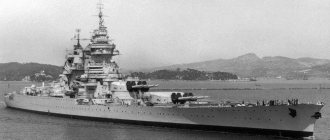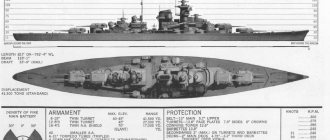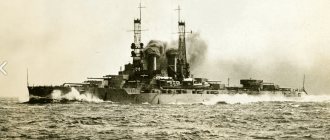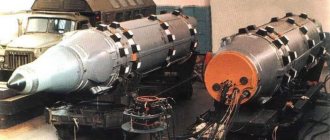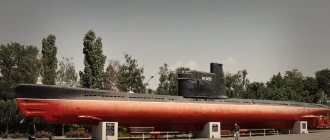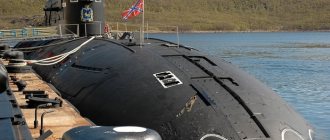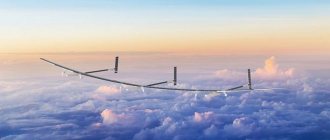TASS DOSSIER. On July 20, 2022, the Russian Navy flag was solemnly raised on the Project 20380 corvette “Sovershenny”. Built at the Amur Shipyard (Komsomolsk-on-Amur, Khabarovsk Territory), the ship became part of the Pacific Fleet of the Russian Navy.
Project 20380/20385 ships are a series of multi-purpose corvettes (patrol ships) for the near sea zone. Developed by the Central Marine Design Bureau "Almaz" (St. Petersburg) in the late 1990s - 2000s. General designer - Alexander Shlyakhtenko, chief designer - Igor Ivanov. The ships are designed to perform escort and strike missions in the near sea zone, patrol coastal waters, and patrol duty.
Armament
Armament - launchers of anti-ship missiles "Caliber-NK" or "Uran" (depending on the modification of the ship), anti-aircraft missile system "Kortik-M" or "Poliment-Redut", two artillery mounts AK-630M 30 mm caliber, artillery mount A-190 100 mm caliber, two 14.5 mm machine gun mounts and two DP-64 grenade launchers. Anti-submarine and anti-torpedo protection - two torpedo tubes of the “Packet” complex of 330 mm caliber.
The Ka-27 helicopter can be based on the ship.
Serial, but different in their uniqueness, corvettes
As often happens with all new projects, the ships encountered a lot of criticism along their paths. Basically, the insufficient cruising range was criticized. However, this is still due to the fact that previously the class of corvettes itself was not in service with the Russian Navy. Skeptics should understand that the very list of tasks facing the Navy has changed significantly. Today, having dozens of corvettes at your disposal is much more important than having a small number of ocean-going destroyers.
Discussions often arose over the ship's weapons; security and survivability were raised in doubt. However, it is also difficult to pay attention to these qualities if you do not have at least a general idea of the tactical schemes that characterize the corvette classes themselves. Although the project itself is promising, it is not yet perfect.
In the first few years of service and combat activity on the Steregushchy, problems with the main power plant appeared twice. These emergency situations became the pretext for comparing the “diesel-diesel” with the gas turbine engine, which is more reliable and lighter, but incomparably more expensive.
Also, the corvette “Boiky” was unable to immediately enter service when problems were discovered in the 100-millimeter gun mount. “Universal” refused to operate under normal conditions, and not only on Project 20380 itself. The same fate befell the Indian frigate from the Russian manufacturer.
Be that as it may, the main advantage of all corvette-type ships is their flexibility. Diesel installations have the potential for modifications, artillery installations can be replaced, but the ships themselves will not remain on the stocks and will not turn into “unfinished construction”. According to the corvette developers, none of the ships will repeat the previous one. Actually, because of the flexibility, availability, serial production and, in the future, mass production of Russian-made corvettes, Project 20380 expects great success, as do all Russian Navy forces.
Modifications
- 20380P and 20383 - projects of border patrol ships (not implemented); - 20382 - export version, capable of performing tasks in the far sea zone (not implemented); - 20385 - modernization of the basic project with enhanced anti-aircraft missile and anti-ship weapons. Initially, it was planned to install diesel units from the German company MTU Friedrichshafen on ships of this modification, but after the company refused to supply engines due to the sanctions imposed against the Russian Federation in 2014, it was decided to use Russian-made units. - 20386 - project of a new generation corvette with modular weapons, a superstructure made of composite materials, reduced radar signature compared to its predecessors, increased displacement (3 thousand 400 tons) and cruising range (9 thousand 260 km), reduced crew size (80 people ).
Project history
The new Russian multi-purpose patrol ship of the near sea zone of Project 20380 was designed for the Russian Navy at the Federal State Unitary Enterprise Central Marine Design Bureau "Almaz" in St. Petersburg. Its creation was due to certain difficulties associated with the implementation of the previous multi-purpose ship of a similar class, Project 12441, since the lead ship “Novik”, laid down back in 1997 at the shipyards of the Yantar Shipyard, was never completed at the time. In this regard, after a competition, in which the FSUE TsMKB Almaz won, the command of the Russian Navy decided to begin construction of a simpler and cheaper ship, Project 20380, which was classified as a corvette (previously, such a class did not exist in the USSR Navy, and similar ships were classified as TFR). Direct military-scientific support for the creation of this ship was carried out by the 1st Central Research Institute of the Ministry of Defense of the Russian Federation. In total, more than 70 Russian research, design and industrial enterprises (including Aurora, Kolomna Plant, Sredne-Nevsky Shipyard, etc.) took part in the creation of the corvette Project 20380.
Multi-purpose patrol ship (corvette) pr. 20380 is designed for operations in the near sea zone of the state and combating enemy surface ships and submarines, as well as for artillery support of amphibious assault forces during amphibious landing operations by launching missile and artillery strikes on ships and vessels at sea and bases, patrolling the area of responsibility for the purpose of blockade.
Series of ships
Currently, four Project 20380 corvettes are serving in the Russian Navy, and construction of six more is underway. As part of the state program for the development of weapons for 2011-2020, the Ministry of Defense of the Russian Federation in 2011 signed a contract with JSC Shipbuilding (St. Petersburg) for the construction of nine ships of the modernized project 20385. However, in May 2015, representatives of the plant reported that project 20385 was being phased out due to problems with imported components. Two ships will be built on it (“Gremyashchiy” and “Provorny”) with the replacement of foreign components with domestic ones, the remaining ships will be built according to the modernized project 20380. — The lead ship of project 20380 “Steregushchy” (hull number 530, serial number 1001) was laid down December 21, 2001 at the Severnaya Verf, launched on May 16, 2006, in the Baltic Fleet from February 28, 2008 - The first production corvette - Soobrazitelny (tail number 531, serial 1002), laid down on May 20 2003 at the Severnaya Verf, launched on March 31, 2010, in the Baltic Fleet from October 14, 2011 - "Boikiy" (board number 532, serial 1003) laid down on May 27, 2005 at the Severnaya Verf ", launched on April 15, 2011, as part of the Baltic Fleet from May 16, 2013 - "Perfect" (serial number 2101) laid down on June 30, 2006 at the Amur shipbuilding Stoiky" (side number 545, serial 1004) laid down November 10, 2006 at the Severnaya Verf, launched on May 30, 2012, in the Baltic Fleet from July 18, 2014 - "Gromky" (serial number 2102) laid down on April 20, 2012 at the Amur Shipyard, transfer the fleet is expected in 2022 - “Hero of the Russian Federation Aldar Tsydenzhapov” (serial number 2103) was laid down at the Amur Shipyard on July 22, 2015. The corvette is named after the sailor from the destroyer “Bystry” Aldar Tsydenzhapov, who on September 24, 2010 prevented a fire in engine room of the ship, and died a few days later from his burns. The sailor’s actions saved the ship and the lives of the rest of the crew. On November 16, 2010, Tsydenzhapov was posthumously awarded the title of Hero of the Russian Federation. — “Rezkiy” (serial number 2104) was laid down on July 1, 2016 at the Amur Shipyard. — “Retivyy” (serial number 1007) was laid down on February 20, 2015 at the Severnaya Verf shipyard. — “Strict” (serial number 1008) was laid down on February 20, 2015 at the Severnaya Verf shipyard. The contracts provide for the construction of four more ships of the series at Severnaya Verf (serial numbers 1010-1013), two at the Amur Shipyard (serial numbers 2105-2106). There is an option for two more ships.
Also, two corvettes are being built at Severnaya Verf according to the revised project 20385: - "Gremyashchiy" (serial number 1005) laid down on February 1, 2012, launched on June 30, 2022, delivery to the fleet is expected before the end of 2022 - "Provorny" " (serial number 1006) was laid down on July 25, 2013, launching is expected in 2022.
Another corvette is being built at Severnaya Verf under project 20386: - “Daring” (serial number 1009) was laid down on October 28, 2016.
Corvette "Staudy"
Corvette "Stoikiy" is the third production corvette in Project 20380, built for the Baltic Fleet. This is already a fundamentally new ship for the Russian Navy, the tactical, technical characteristics and combat properties of which are an order of magnitude superior to similar ships in its class.
The most important feature of the Corvette is that it is sharper, more multifunctional, flexible, compact, unobtrusive, with a high level of automated and integrated systems. The project provides significant potential for its further modernization. The project 20380 corvette with a displacement of more than two thousand tons, a length of one hundred meters and a width of thirteen meters reaches a speed of up to twenty-seven knots. The range of sea crossings that the ship can make has been increased to four thousand nautical miles. The ship is no longer as loud as its predecessors were.
The corvette is armed with a hundred-millimeter universal artillery system and an anti-aircraft missile and artillery system. In addition, it is armed with supersonic missiles and automatic artillery mounts. The air group of this ship, however, as in previous corvettes, included one Ka-27PL helicopter. The ship received a strict appearance that meets all modern requirements of stealth technology.
Hand in hand
The introduction of a unified combat information and control system can be called the main innovation in Project 20380, which influenced the tactical characteristics of ships, the crew’s accommodation, the reliability of all technical equipment, as well as the rapid modernization of weapons. Previously, the systems were located in different places on the ship, and all coordination was entrusted to the crew. This is now entrusted to the integrated bridge system, which controls all ship systems, from mechanical to weapons.
There are also a couple of components in the integrated bridge system:
- Missile and anti-submarine warfare control section;
- Section for control of radar warfare and illumination of air, surface and underwater conditions.
The first section has three posts located hand in hand right next to the captain's bridge. These are the places of work of warhead commanders. One is engaged in anti-submarine warfare, and the second is in charge of the anti-ship complex. The appearance of their posts is almost the same. It consists of large screens that display information about targets and combat systems. The corvette commander and the watch officer have the same screens.
The third warhead commander coordinates all weapons systems, and also issues recommendations to the ship commander in cases of weapon use. An important aspect is the fact that the ship’s commander, the helmsman, the watch officer, as well as the warhead commanders are within the walls of the same room, and this contributes to the lightning-fast adoption of coordinated decisions and their immediate execution.
Corvettes are equipped with weapons coordination systems and multiple target detection systems. The technical aspects are almost unknown, but it is noted that each new system on a new ship becomes even stronger.
Its essence is that information about air, surface and underwater conditions, about detected targets and communications, is concentrated as a single center and is also processed. The system determines the dangerous level of the target and makes a decision on the type of weapon that needs to be used. Then this information is sent at lightning speed to nearby ships, helicopters and airplanes for the general coordination of further activities.
It would be logical to use such a system in cooperation with helicopters, which are invulnerable to submarines, and the use of active hydroacoustic detection means has undeniable advantages over ships when illuminating underwater conditions. The maximum automation of all ship systems led to a manifold reduction in the time required to make any decision, as well as facilitating the work of the crew and reducing its number to one hundred military personnel.

